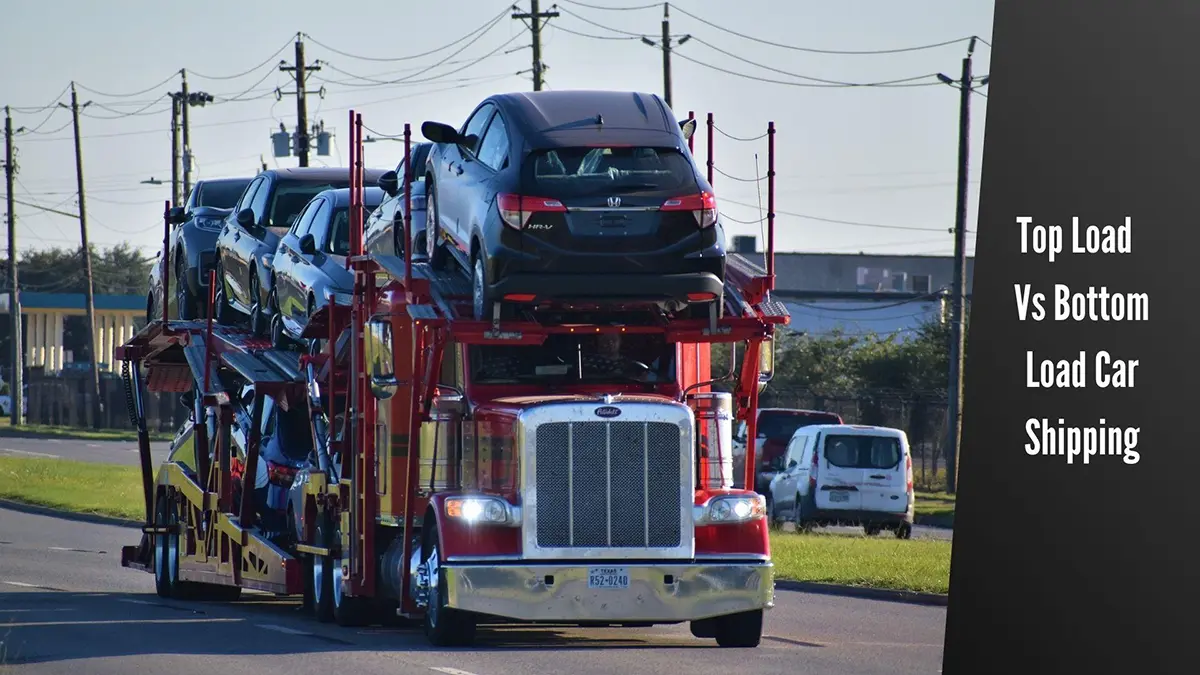Have you ever watched the loading of a car transporter and wondered - why some vehicles are driven up to the top ramp while others are moved to the bottom deck? As vehicle owners looking to move their prized possessions cross country, this decision likely factors into your budget and transport timeline.
In our decade of experience shuttling thousands of autos annually across land and sea, we’ve seen top-load transport and bottom-load car shipping play an integral role in the multi-billion dollar vehicle logistics industry.
So before you decide how best to transport your car, SUV, or truck, let’s dive into a comparative analysis of these two techniques.
What’s Bottom and Top Load in Car Transportation?
Have you ever wondered how your car gets loaded onto a transporter when you hire car transport services? There are generally two ways your car can be loaded - bottom loading and top loading.
- Bottom Loading (also called Deck Loading): As the name suggests, your car will be driven up ramps and onto the bottom deck of the transporter. It is then securely strapped in place for the journey ahead. This method for loading a car transporter is best suited for smaller vehicles that can easily fit inside the transporter deck. Your car’s underside is protected from road grime and elements.
- Top Loading : Here, your car is driven up ramps and positioned on the top deck of the transporter in the open. It is then firmly tied down with straps to the transport deck. Top load transport is suitable for larger vehicles, like trucks or SUVs, that may not fit within the enclosed deck. While the top is exposed, it allows for quick loading and unloading of vehicles.
Top Load vs Bottom Load Car Shipping:
Whether you’re moving to a new city or taking a cross-country road trip without the trip, shipping your precious car safely is a top priority (pun intended). While the goal is getting your wheels from point A to B in one piece, the method of transport matters. As any frequent mover knows, choosing between top and bottom-load car transport can be challenging. While both loading methods have pros and cons, here are 5 key differences to help you determine the right way for loading a car transporter for your situation:

Ease of Loading
For most vehicles, top-load transport is the easier option. Getting your car positioned atop the carrier takes less precision and effort compared to guiding it into a tight bottom rack. Simply drive straight onto the platform, and you’re set! However, low-profile cars may be tricky to top load.
Dirty Arrival
During car transport, vehicles at the bottom deck are more prone to gettingdirty for several reasons. Firstly, they’re close to the road surface, so they’re in direct contact with all the dirt and gravel on the road. Moreover, if any vehicle on the top deck leaks fluid, it’ll directly get on the cars parked below. Top-load cars are safe from these issues.
Vehicle Access
Need to drop items in the trunk during the trip? Only bottom-load transports allow easy access to your vehicle without much effort. Top load means a bit more choreography, getting items in and out. But top accessibility still beats crowded parking garages!
Journey Length
The longer the trip, the more effective bottom loading may be. Top loads endure nonstop sun, wind, and weather for full transport. So cross-country hauls suit bottom rack placement better. Short local moves are usually fine with top loading.
Cost Comparison
On average, expect to pay 5-10% more for top-load transportation. That premium may be worth it for prized exotics or classic collectibles if you want them to arrive neat and clean after a long coast-to-coast transport. But a bottom load gets ordinary daily drivers to their new homes just as safely for less money.
| Criteria | Top Load Transport | Bottom Load Transport |
|---|---|---|
| Ease of Loading | Easier, requires less precision. | May be trickier, especially for low-profile cars. |
| Dirty Arrival | Cleaner; less exposure to road debris and fluid leaks. | More prone to dirt and potential fluid leaks from vehicles above. |
| Vehicle Access | Requires more effort to access the trunk during the trip. | Easy access to the vehicle, convenient for dropping items. |
| Journey Length | Suitable for short moves; exposed to elements throughout. | Effective for longer trips, shielding from continuous exposure. |
| Cost Comparison | Typically 5-10% more expensive. | Generally less expensive; suitable for daily drivers. |
Consider your vehicle type, journey length, budget, and risk tolerance to determine the best Loading A Car Transporter method. Both get the job done - one may just suit your needs on the road better than the other. Give us a call to discuss transport options - we’re always happy to help you travel top!
Which One to Choose Between Top vs Bottom Load? The Golden Rule!
Wondering which option is right for your specific vehicle and transport needs? You’ve come to the right place - we’ve seen it all in our years in the car transport business, and we’re here to break down the top vs. bottom debate.
Open Top Cabinets = Top Load
If your car has a roof rack or open-top storage compartments that you need to keep accessible during transport, a top load is an obvious choice. With this Loading A Car Transporter configuration, your vehicle will be driven onto the transport and secured facing down so the roof and any open-top accessories remain easily accessible. Some of our frequent top loads are Jeep Wrangler owners who need access to their roof baskets or spare tire covers, minivan owners who need their roof racks clear, and convertible owners who don’t want their soft tops crushed under another vehicle for hundreds of miles.
Low Ground Clearance = Bottom Load
On the other hand, if your vehicle has limited ground clearance like many low-profile sports cars or luxury SUVs, a bottom-load transport is best to avoid any risk of damaging the front or rear ends on the ramps. With a bottom load, your car is driven onboard backward and strapped facing upwards. For instance, if we move a Lamborghini Huracan, we’ll bottom load it because, with its ground clearance of just 4.1 inches, even our gentle ramps pose too much of a risk for a top load.
Distance matters for wear and tear
For longer hauls over 1,000 miles, the stress and wear of being wrapped up and strapped down for extended periods generally make a top load kinder on your car– though both methods are completely safe. The suspension has less weight to carry top-side, and there’s no risk of exterior damage from road grime and pebbles kicking up onto the underbody from tires overhead. Some of our most frequent multi-state top loads are shiny new Teslas, with their low profiles and owners’ attention to flawless bodywork. But for shorter trips under 500 miles, either method is still perfectly acceptable.
How Easy Auto Ship Helps Those With Bottom Load:
Struggling to load your ride on the top? Don’t feel left out on the bottom.
We know how stress-inducing it can be to find the method of loading a car transporter that fits your needs, especially if your vehicle is lower to the ground. That’s why our bottom load transport is designed with careful drivers and your car’s peace of mind.
We have an extensive fleet able to handle almost any vehicle down low. Whether you’re shipping a coupe, convertible, or something in between, rest assured our experienced handlers have you covered - and your ride cushioned throughout the trip.
From start to finish, safety is our top priority. We take extra care to securely strap multiple strategic points on each car on the bottom level. Together with our pneumatic suspension, this multi-point system helps filter out bumps in the road to keep behaviors in check. Drivers are also rigorously trained to navigate smoothly and watch out for low clearances.
The peace of mind continues even after arrival. Upon delivery, we’ll perform a walkaround inspection with you. This allows you to double-check and see for yourself that your car arrived in the same fine fettle it left in.
So don’t hesitate to go either way, top or bottom, with us - we’ve got you and your car comfortably situated. Give us a call today to discuss all your transport needs. Whether top or bottom, we’ll have the right load transport solution to get you where you need to go, car and worries in tow.
Frequently Asked Questions
What is a full load in trucking?
A full truckload (FTL) refers to a trailer that is loaded at or near its maximum weight capacity with goods from a single shipper. This is the most efficient way to transport goods via trucking as it maximizes the cargo space.
What is the best spot on a car carrier?
The front-center and rear-center positions on a car carrier are generally best as they provide the smoothest ride. The center spots absorb shock better from road conditions. Front and rear corners can experience more bumping.
What does top load mean in car shipping?
Top load refers to securing vehicles to the roof of the transport truck or trailer. Smaller passenger vehicles or cars can be strapped safely above the main cargo area. This allows the carrier to transport more vehicles per trip.
Are car carriers safe?
Modern auto carriers are very safe modes of transportation when carriers follow regulations regarding vehicle securement, load weight distribution, and driving protocols. However, accidents can still occur from other vehicles, weather, or road conditions. Proper carrier selection helps ensure safety.
What is the top loading capacity for trucks?
Top loading refers to stacking cargo above the cargo area of a truck or trailer. Top load capacity can vary depending on the type and size of the truck but is usually limited to a specific weight like 3000-5000 lbs that is distributed evenly across the roof. Following proper loading techniques is important for safety.
What documents are needed for top loading a vehicle?
When top-loading a personal vehicle for transport, you’ll typically need a bill of lading from the carrier that describes the vehicle and includes weight and cargo securement details. The vehicle owner should also provide title/registration and signed documents authorizing the carrier to transport the vehicle secured to the roof of the truck in the specified manner. Insurance for the vehicle is also recommended.
How is a car secured for top loading?
Proper securement is critical for safety. The vehicle should be strapped down with sturdy ratchet straps at several connection points like the tires, chassis, and any available anchor points on the roof. Additional stabilizers or tie-downs may be used. The vehicle should not move more than an inch in any direction during transport. The carrier is responsible for ensuring proper securement.
What vehicles can be top-loaded?
Generally, smaller passenger vehicles like cars, SUVs, and smaller trucks can be top-loaded as long as the combined weight of vehicles does not exceed the truck’s rated capacity. Larger vehicles may not be suitable due to weight distribution or securement challenges. Consult the carrier for vehicle size guidelines.
Should I insure my vehicle for top-load transport?
Purchasing cargo insurance for any vehicle being transported is generally recommended, especially when top-loaded. While carriers are responsible for proper securement, additional coverage can provide peace of mind in case of an accident. Cargo insurance is relatively inexpensive and helps protect the vehicle’s value through the transport process.





